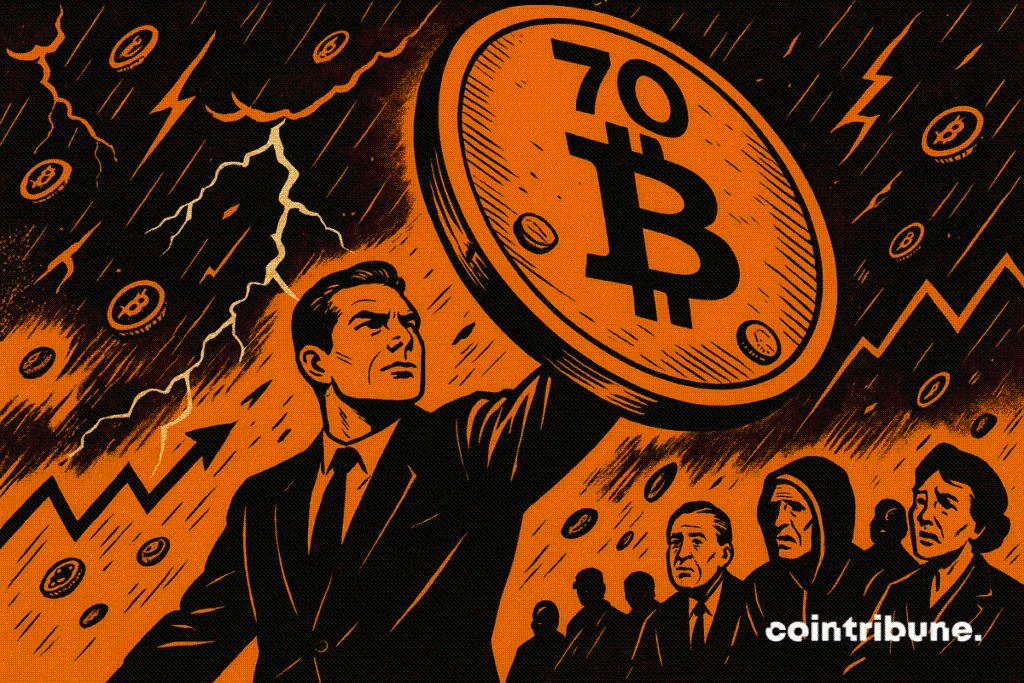Strategy unveils a new anti-panic weapon against the bitcoin crisis
Since the fall of bitcoin, Strategy’s strategy worries more than one. Faced with this, the company has just unveiled a new tool. A move to reassure crypto investors and maintain its role as an institutional pillar. More details in the following paragraphs!

In brief
- Strategy launches a BTC Rating to reassure markets after the marked bitcoin drop.
- The company claims 70 years of financial margin, even if the bitcoin price remains stagnant.
Strategy counter-attacks with a BTC Rating
The BTC Rating is an indicator expressly designed by Strategy. It is supposed to reflect the company’s debt strength following the recent market turbulence on bitcoin.
More explicitly, the BTC Rating relies on the notional value of preferred shares. It shows that even if bitcoin falls to $74,000 (its average purchase price), Strategy retains an asset/debt ratio of 5.9. If the price collapses to $25,000, the ratio will remain at 2.
In both cases, the liquidity would allow dividends to be paid for 70 years. A projection that some consider ambitious but credible in a flat market scenario.
This communication aims to dispel the fear of a domino effect on the stocks of companies related to digital assets, often called DAT (Digital Asset Treasuries). The BTC Credit Dashboard published by Strategy centralizes these key data.
Debt, dividends and mNAV: the new equation of bitcoin strategy’s strength
Alongside this BTC Rating , another indicator attracts attention: the mNAV (Market Net Asset Value). This index compares the enterprise value to that of crypto holdings (notably bitcoin).
With a score of 1.16, Strategy can theoretically still raise funds by issuing shares. A capacity no longer available to some struggling players like Bitmine and Sharplink Gaming.
Some analysts confirm this strength. According to them, the dividend strategy holds up long-term (unless there is a sudden regulatory change). For others, Strategy’s continuous accumulation of bitcoin could slow future drops by absorbing part of the supply. These reserves, considered “off-market,” thus block an additional selling pressure.
While the crypto market remains volatile, the signals sent by Strategy thus reinforce its position as an institutional bastion for bitcoin. The company becomes a reference to follow in the assessment of crypto risks.
Disclaimer: The content of this article solely reflects the author's opinion and does not represent the platform in any capacity. This article is not intended to serve as a reference for making investment decisions.
You may also like
Bitcoin News Update: S&P Lowers Tether's Rating Due to Risky Holdings and Lack of Transparency, Raising Concerns About Stablecoin Stability
- S&P downgrades Tether's USDT to "weak," citing high-risk reserves (24% in Bitcoin/gold) and opaque operations. - Tether's 5.6% Bitcoin allocation exceeds overcollateralization margins, risking undercollateralization amid crypto volatility. - Analysts warn Tether's gold/Bitcoin purchases (2% of global demand) could destabilize markets, while regulatory scrutiny intensifies. - Despite $10B+ 2025 profits, Tether defends its "digital dollar" role, though S&P flags structural risks like custodian transparency

Canada’s Authorization of CAD Stablecoin Connects Conventional and Digital Finance, Establishing a Regulatory Benchmark
- Canada approves QCAD, the first regulated CAD-backed stablecoin, after years of collaboration with securities regulators. - DeFi Technologies plans to scale QCAD through exchange-traded products, yield solutions, and quantum-resistant security partnerships. - The stablecoin's 1:1 CAD reserve structure and public audits aim to bridge traditional finance with blockchain while ensuring transparency. - DeFi's stock surged 16% post-approval, reflecting investor confidence in its strategic role in Canada's dig
Is the Increased Efficiency of Blockchain Worth Weakening Market Protections?
- WFE warns SEC against crypto exemptions for tokenized stocks, citing risks to market integrity and investor protections. - SEC under Trump proposes "innovation exemption" to let unregistered crypto firms offer blockchain-linked equity tokens. - Traditional exchanges like Nasdaq seek regulated tokenization, while WFE fears reputational harm from unlicensed platforms. - Critics highlight risks of confusing tokenized assets with real equity ownership and potential erosion of compliance standards.
Xerox Campus Transformation and Webster's $9.8 Million FAST NY Award: A Pivotal Moment for Property and Infrastructure Investment?
- New York's $9.8M FAST NY grant revitalizes Xerox Webster Campus, a 300-acre brownfield for high-tech manufacturing. - State-funded infrastructure upgrades enable 1M sq ft industrial space, aligning with Governor Hochul's "sustainable economic ecosystem" vision. - Public-private partnerships reduce developer risks, creating shovel-ready sites to attract semiconductors and renewable energy sectors. - Investors face opportunities in first-mover advantages but must weigh risks like tenant delays and cyclical

